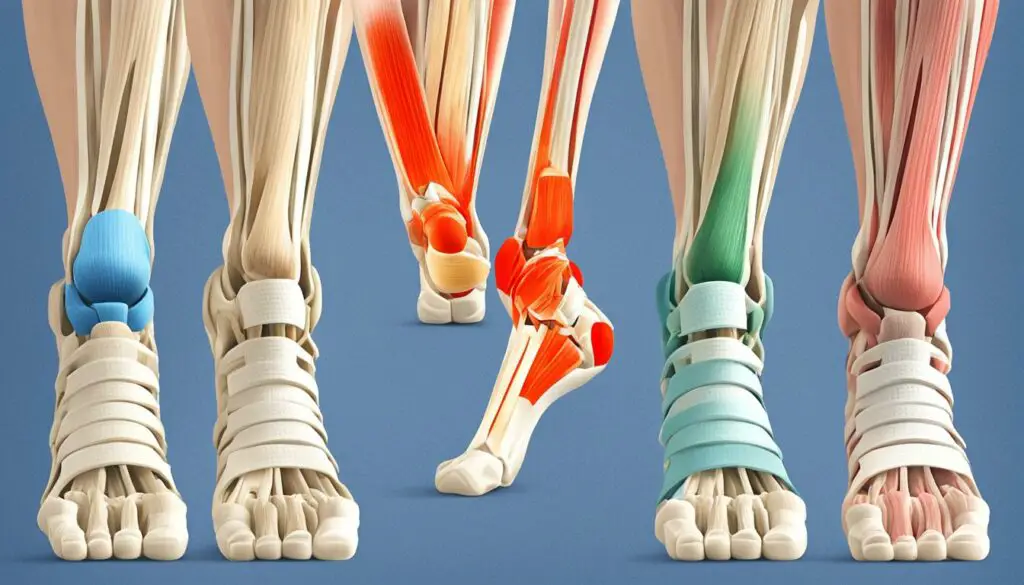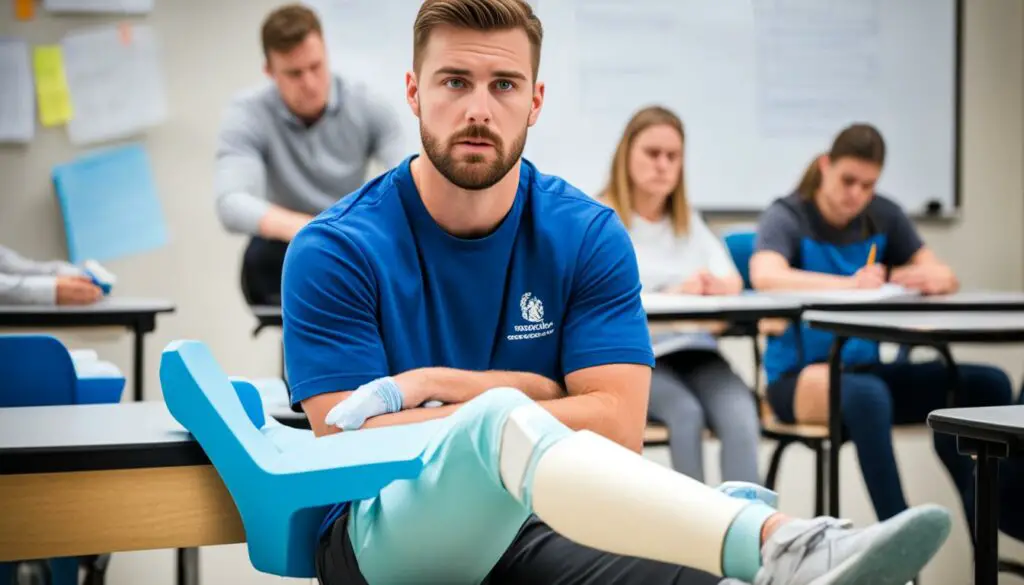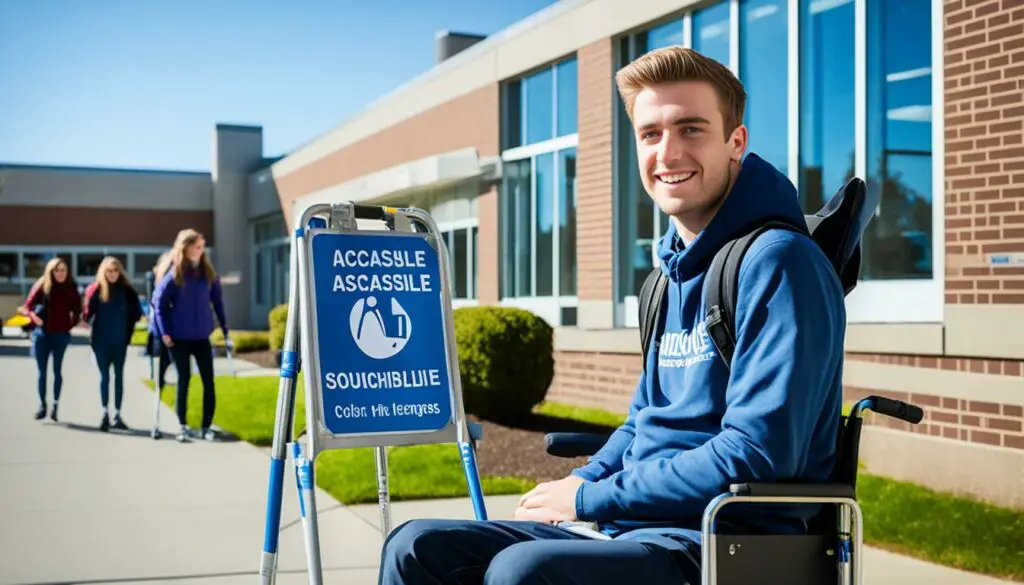Attending School With a Sprained Ankle: Is It Safe?
When your child suffers a sprained ankle, deciding whether to attend school or stay home can be challenging.
Can my child go to school with a sprained ankle? Is it safe for them to navigate the hallways and participate in activities? These are common concerns that parents face. But what if attending school with a sprained ankle is not as risky as it seems?
Let’s explore the factors to consider and determine if sending your child to school is the right choice.
Understanding the Different Grades of Ankle Sprains
Ankle sprains can be classified into different grades based on their severity. It is essential to understand the various grades to determine the appropriate course of action for treatment and recovery.
Grade 1 Ankle Sprain: Mild Injury
A grade 1 ankle sprain is the mildest form of ankle sprain. It involves stretching or slight tearing of the ligaments. Although painful, individuals with a grade 1 sprain can often continue their normal activities with appropriate support.
For school attendance, a mild ankle sprain may not hinder a child’s ability to go to school. Using crutches or bracelets, they can still navigate the school environment without significant inconvenience. However, monitoring the pain levels and consulting a healthcare professional for personalized guidance is crucial.
Grade 2 Ankle Sprain: Moderate Injury
A grade 2 ankle sprain is a moderate injury involving partial ligament tearing. Compared to a grade 1 sprain, the pain and swelling are usually more intense. These sprains typically require a few days of rest at home to allow for healing.
For school attendance, a child with a moderate ankle sprain might need to temporarily stay home until the pain subsides and weight-bearing becomes more manageable.
During this time, they can focus on recovery without the pressure and potential risks of attending school. It is essential to follow the guidance of a healthcare professional in determining the appropriate duration of absence from school.
Grade 3 Ankle Sprain: Severe Injury
A grade 3 ankle sprain is the most severe type and involves a complete tear of the ligaments. The pain, swelling, and instability are significant, making bearing weight on the affected ankle challenging.
For school attendance, a child with a severe ankle sprain may need to stay home until the pain subsides and they can bear weight on the injured ankle.
🌟 Hey Students! 🚀 Ready for the ultimate experience? Join us on Studentsinside.com's Facebook, YouTube, WhatsApp, and LinkedIn. Click now for tips, fun, and success vibes! 🌈✨ #StudentLife #JoinUs
Returning to school too soon can hinder healing and increase the risk of further damage. It is crucial to prioritize rest, follow the recommended treatment plan, and consult a healthcare professional for proper guidance.

| Ankle Sprain Grade | Severity | Treatment | School Attendance |
|---|---|---|---|
| Grade 1 | Mild | Supportive measures: ice, compression, elevation | Possible with appropriate support |
| Grade 2 | Moderate | Rest, ice, compression, elevation | Temporary absence may be necessary |
| Grade 3 | Severe | Rest, ice, compression, elevation, possible surgery | Temporary absence until pain subsides |
Managing Pain and Swelling at School
To alleviate pain and swelling from a school-related sprained ankle, implement these effective strategies to ensure your child’s comfort throughout the day.
Elevation
Encouraging your child to elevate their foot whenever possible can help reduce pain and swelling. Prop up their injured ankle on a pillow or stack of books while sitting or lying down. Elevating the foot above the heart level allows gravity to assist in draining excess fluid from the injured area, minimizing swelling.
Ice
Use ice packs wrapped in a cloth for short intervals to alleviate a sprained ankle. This method effectively numbs the area and reduces inflammation. Advise your child to keep the ice pack on for 15-20 minutes, followed by a 30-minute break before reapplying. Always avoid direct skin contact with the ice to prevent ice burns.
Compression
Compression techniques can provide ankle stability and help reduce fluid buildup. Consider having your child wear a supportive ankle brace or an elastic bandage to wrap around the injured area. Compression helps control swelling and provides extra support during movement, promoting better pain management throughout the day.
Over-the-Counter Medication
Over-the-counter nonsteroidal anti-inflammatory drugs (NSAIDs) like ibuprofen or acetaminophen can be taken for temporary pain relief. These medications help reduce pain and inflammation. However, following medical guidance for appropriate dosage and potential side effects is essential. Consult a healthcare professional for personalized advice.

Asking for Accommodations at School
When a child has a sprained ankle, specific accommodations can be requested from the school to support their recovery. Some accommodations may include:
- Extra time between classes to avoid rushing or straining the ankle
- Requesting an elevator pass for multi-level schools
- Obtaining a temporary handicapped parking permit for easier access
- Participating in a modified physical education (PE) class

When to Keep Your Child Home from School
While it is generally safe for children with a mild to moderate sprained ankle to attend school, there are certain situations when it’s best to keep them home for their well-being and recovery.
Severe Pain:
If your child is facing intense pain affecting their focus and hindering classroom participation, it’s advisable for them to remain at home. Such severe pain could signal a more significant injury, necessitating rest and prompt medical attention.
Heavy Pain Medication:
If your child requires heavy pain medication to manage their sprained ankle, it may cause drowsiness and affect their ability to focus and participate in school activities. In this case, it’s best to keep them home until they no longer need medication or until it can be managed with over-the-counter options.
Difficulty Walking or Risk of Re-Injury:
If your child has difficulty walking or is at an increased risk of re-injury due to a sprained ankle, it’s important to prioritize their safety and keep them home. Limping or favoring the injured ankle can strain other body parts and delay healing.
Fever or Flu-Like Symptoms:
If your child develops a fever or flu-like symptoms along with a sprained ankle, it is advisable to keep them home. These symptoms may indicate an underlying illness or infection, and rest at home will support their overall recovery.

What Is a Sprained Ankle and How Is It Treated?
A sprained ankle occurs when the ligaments around the ankle are stretched or torn, a common injury among athletes. Severity varies, and treatment often involves the RICE method:
1. Rest: Give your ankle a break to prevent further damage. Avoid putting weight on it and minimize activities that could worsen the injury.
2. Ice: Apply ice for 15-20 minutes every 2-3 hours during the initial days to reduce pain, swelling, and inflammation.
3. Compression: Support and stabilize the joint by wrapping it with a compression bandage or using an ankle brace. Ensure a firm but not overly tight fit to maintain proper blood circulation.
4. Elevation: Elevate the injured ankle above heart level to promote blood flow, reducing swelling. Prop it up on a pillow whenever possible.
In addition to the RICE method, consider over-the-counter pain relievers like paracetamol or ibuprofen, following recommended dosages. Consult a healthcare professional if needed.
Recovery time varies—mild sprains heal in weeks with proper care, while moderate to severe ones may take six weeks or longer. Surgery may be necessary for complete ligament tears in rare cases, restoring stability to the ankle joint.
How to Prevent Ankle Sprains in Children
Preventing ankle sprains in children is essential to ensuring their safety and well-being. One key preventive factor is ensuring that children wear proper footwear that provides adequate support and cushioning for their feet and ankles.
Well-fitting shoes that are appropriate for the specific sports or activities they engage in can help minimize the chances of sprains.
In addition to wearing the proper footwear, regularly stretching before and after sports activities is crucial. Stretching exercises help improve flexibility and promote a better range of motion, reducing the strain on the ankle ligaments during physical exertion.
Encouraging children to perform simple stretches, such as calf stretches and ankle circles, can go a long way in preventing sprains.
You may consider ankle taping or ankle braces for additional protection during sports activities. These measures can provide extra stability and support to the ankle joint, reducing the likelihood of sprains, especially if your child has previously experienced an ankle injury.
Before allowing children to return to sports, it is crucial to prioritize complete recovery. Allowing ample time for rest and rehabilitation ensures that the ankle has fully healed and minimizes the chances of re-injury.
FAQ
Q: Can my child go to school with a sprained ankle?
A: In most cases, it is safe for a child with a mild or moderate ankle sprain to go to school as long as they can walk without significant pain and don’t require heavy pain medication. However, the severity of the sprain and the individual circumstances should be considered, and it’s always best to consult with a pediatrician for personalized guidance.
Q: What are the different grades of ankle sprains?
A:
Ankle sprains vary in severity and are categorized into three grades.
Grade 1: This is the mildest form, involving slight ligament stretching or tearing. Students with a grade 1 sprain can typically attend school with the support of crutches or braces.
Grade 2: This moderate injury is characterized by partial ligament tearing. Resting at home for a few days is usually recommended to facilitate healing.
Grade 3: This is the most severe type, involving a complete ligament tear. Students with a grade 3 sprain may need to stay home from school until the pain subsides and weight-bearing becomes possible.
Q: How can I manage pain and swelling from a sprained ankle at school?
A: To manage pain and swelling caused by a sprained ankle at school, encourage your child to elevate their foot whenever possible. Applying ice packs wrapped in a cloth for short periods can help reduce inflammation.
Compression with a supportive ankle brace or elastic bandage can provide stability and reduce fluid buildup. Over-the-counter nonsteroidal anti-inflammatory drugs (NSAIDs) like ibuprofen or acetaminophen can be taken for temporary pain relief, but always follow medical guidance for appropriate dosage and potential side effects.
Q: Can I request accommodations from the school for my child with a sprained ankle?
A: When a child has a sprained ankle, the school can request specific accommodations to support their recovery. Some accommodations may include extra time between classes to avoid rushing or straining the ankle, requesting an elevator pass for multi-level schools, obtaining a temporary handicap parking permit for easier access, and participating in a modified physical education (PE) class.
Q: When should I keep my child home from school with a sprained ankle?
A: There are certain situations when it’s best to keep your child home from school with a sprained ankle. Severe pain that affects their ability to concentrate, the need for heavy pain medication that may cause drowsiness, difficulty walking, or a risk of re-injury, and the presence of fever or flu-like symptoms are all valid reasons to prioritize rest and recovery at home. It’s always important to consult with a healthcare professional for personalized advice on when it’s appropriate for your child to return to school.
Q: What is a sprained ankle, and how is it treated?
A: A sprained ankle involves stretching or tearing of ankle ligaments. Use the RICE method: rest, ice, compression, and elevation. Apply over-the-counter pain relievers for temporary relief. Mild sprains recover in weeks, while severe ones may take six weeks or more. Surgery is rare, reserved for complete ligament tears.
Q: How can ankle sprains be prevented in children?
A: Ankle sprains can be prevented in children by ensuring they wear proper, well-fitting footwear, regularly stretching before and after sports activities, avoiding sharp turns and quick changes in direction, and considering ankle taping or wearing ankle braces during high-risk sports, especially if they have had a previous ankle injury.
It’s crucial to address ankle sprains promptly and allow for complete recovery before allowing children to return to sports to minimize the risk of re-injury and ensure a safe return.








